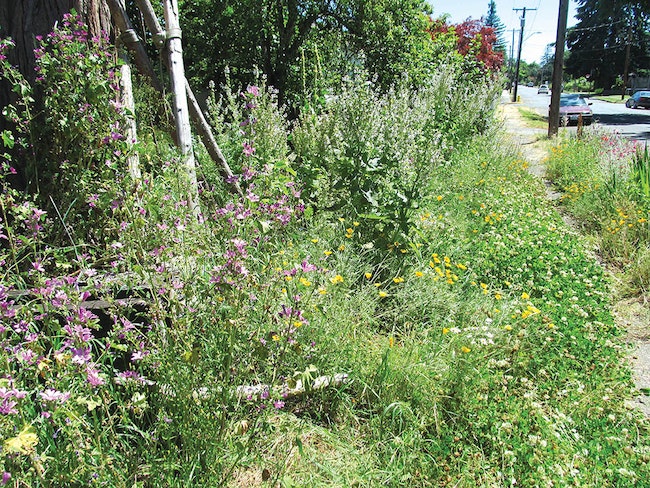 The yard/bee habitat is a delight for nature-lovers using their property to sustain life and our planet. It can also make it hard to use the public sidewalk.
The yard/bee habitat is a delight for nature-lovers using their property to sustain life and our planet. It can also make it hard to use the public sidewalk.
My neighbors won the coveted “Yard of the Week” designation this past week. The sign stands proudly in the yard and rightly so. My neighbors work hard at making their yard neat, manicured, and beautiful. Flowers bloom in a steady succession stretching spring colors over a long season. That requires both foresight and plant knowledge to pull off.
I don’t think my yard will ever be selected for a similar recognition. Not that I don’t spend a fair amount of time and effort working in it. No, I just have a different goal in what I am working toward. And that is more than okay. The idea of “live and let live” is a big part of what drew me to Oregon in the first place. I get to enjoy my neighbor’s yard and share the joy that they put into it and also get to have fun on my quarter acre.
At times some may think that my yard is an abandoned property. The grass gets high and there are a lot of what most would call weeds. What looks like neglect is part of what I want from my yard. I have two goals: provide habitat for pollinators and try to produce food.
I do have the advantage of not having any kids at home to need a playing field. I do enjoy the squeals from down the street when some neighborhood kids get the hose going or spend time on the trampoline.
In the food department I have my garden plot, berry bushes, and fruit trees. When we first moved in the old fruit trees had been neglected for a long time. Some prudent pruning over the succeeding years has brought them back to producing fairly well. I try and eat or process every offering from these trees. That includes canning, drying, juicing, baking, and eating fresh fruit. The pantry served us well during the pandemic, breaking into the bounty of past fruit harvests.
I started putting in blueberries as an anniversary remembrance each year and am happy to see them starting to bear well. Strawberries, grapes, and gooseberries round out the fruit department.
The vegetable plot is in the sunniest sector, which the trees on the property have limited to one corner. The soil has been built up over the years with plenty of amendments. Most of them locally sourced manure, leaves, compost, sand, ashes, but on the advice of a farmer friend I turned in some minerals and was pleased to see the improved yields.
Thinking that having honey bees would increase my fruit yields, I added a hive three springs ago. I got them through one winter, but lost them during the next one. Recently my neighbor let me know that a swarm was in their yard and I managed to snag them and convince them to stay. Or at least part of them. They split several times and swarmed up high into the walnut tree where I couldn’t catch them. Even though some took off, they left behind a strong hive. Oh well, free the bees!
Having bees made me more conscious about what was happening in the yard and probably led to what some may call the general decline of its appearance. I started to try to plant more pollen and nectar plants. That includes borage, clovers, spearmint, Phacelia (bee’s friend), lavender, and others. In the clover department are red, New Zealand, white, and crimson clovers.
Besides these specific plantings, I also started focusing on adding native flowering plants. The native red columbine proved not only popular with the bumble bees, but humming birds too. Other Oregon natives I have established are trilliums, fawn lilies, fireweed, camus, tiger lilies, Oregon sunshine, and California poppies
An evolving strategy has led to letting certain weeds gain a toehold in the yard. For instance, I used to pull out the dandelions but now encourage them as one of the important early season bee foods. While some of these weeds are interlopers and are not native I leave them because they do provide good bee fodder. Nipplewort, thistles, mallows, mullein, and asters are allowed to exist.
In deciding on what to leave and what to weed, I have a simple criteria; insect activity. By observing the plant, when blooming, if there are a lot of pollinator visitors on the flowers, it stays. I don’t mean just honey bees. While important, the domestic bee, Apis genus, is not the only game in town when it comes to pollination. Oregon is home to a number of native bees that do a lot of good pollination. In fact when it is rainy and cold and honey bees stay home, these natives are hard at work ensuring that there will be some fruit when the bloom happens at the wrong time meteorologically.
The following excerpt sums it up. From the OSU publication, “Living on the Land: Providing Habitat for Native Pollinators,” 2017: “European honey bees are in decline from colony collapse disorder and other stresses. However, native bees can be better pollinators of some crops than European honey bees. Roughly 4,000 species (500 in Oregon) live in the United States and can help with pollination demands when honey bees are in short supply. For example, only 250 female mason bees are needed to pollinate an acre of apples, a task that would require 15,000 to 20,000 honey bees. Also, many native bees will forage earlier in the season and in colder, wetter weather conditions than honey bees. Unfortunately, native bees are also in decline, particularly certain species of bumble bees.”
“Habitat loss, pesticide use, climate change, and the introduction of diseases all contribute to native bee decline. Protecting or providing habitat for native bees is one of the best ways farmers and property owners can support native pollinators.”
Sounds like my mission statement.
I practice those precepts. The only pesticide I have had to use was some wasp spray on the colony of bald faced hornets who were building a nest under my eaves. But maybe I have gone overboard on the “providing habitat” direction.
Periodically the City of Cottage Grove thinks so. As part of keeping the community safe from fires the city has adopted into the Municipal Code, under nuisances, section 8.12.045, Hazardous vegetation. This rule rightly protects us from having tall, dry, combustible plant material waiting for a spark to set fire in motion, endangering life and property.
I have received notices several years running that I was out of compliance. I do try and keep things down as they bloom out. As much as I like my weeds I don’t want them taking over, so once they have finished flowering, I cut them down to prevent excessive seeding. And I make sure that when things start to dry out, everything is cut down and put to bed. At least I am guiltless when it comes to blackberry bushes.
My grass has evolved from a spotty lawn into a hay field, quite literally. I am a big compost-maker. Because it enriches the soil and sequesters carbon, I try to keep all plant material in my place. In the fall when most people are raking their leaves into the street for pick up, I am hoarding them for mulching, putting them into the garden, and stockpiling the “browns” for my compost piles.
Besides enjoying the colorful blooms of the intentional plants and selected weeds the other reward are the bugs, snakes, and other critters. I know that is probably not what most people want for their yards, but to me it is a sign of success. Looking out over the yard and seeing the flurry of flying insects hovering over the plants, the bees heading out of their hive, and some butterflies flitting about, I am sharing the space with the local fauna.
Insects aren’t all bad and form a big part of the food chain. That makes them essential to the birds that also like to hang out here. Insects don’t seem to bother the vegetable garden and I am sure that the insect predators help keep the bad bugs down.
Please consider stepping over to the wild side.
Maybe not to the extent I have, but adding a few drought-resistant, native, pollinator-friendly plants will provide low maintenance color to your yard. It will also be much-needed support for the good guys who keep the circle of life rolling along.
Contact Dana at [email protected]








